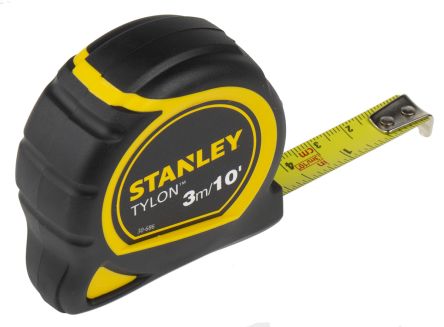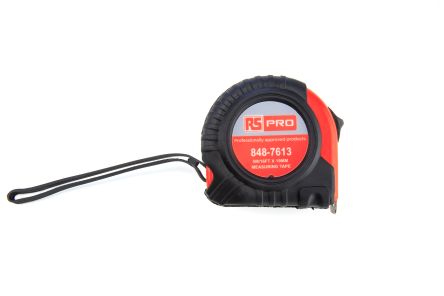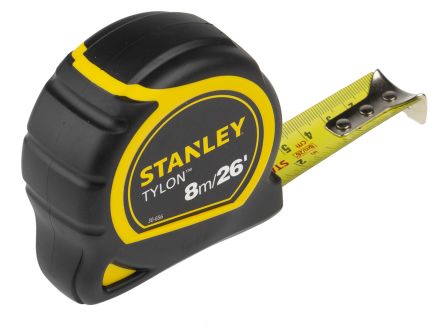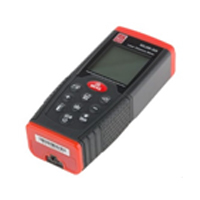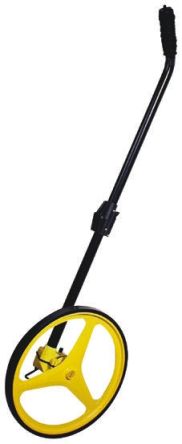
|
What is a tape measure?
A tape measure is a flexible instrument used for measuring lengths and distances; an essential for many industries and applications. From clothes making to carpentry, DIY and masonry, there is no doubt tape measures are an exceptionally popular tool, available in different types and sizes to suit every need and profession.
Despite the variety of shapes and functionalities, most tape measures share a common basic structure, which includes a plastic, steel or fabric strip onto which measurement graduations are marked. Normally, marks are black and red on a yellow background, as this is the best colour combination to make it easy to read.
Popular tape measures
Shop our best selling measuring tapes using the links below:
Types of tape measures
The different applications and environments where the tape measure is needed will determine the best choice among the extensive range of tools available on the market. There are many types and designs suitable for different applications, from surveying and carpentry to DIY. Textile tapes are also an essential item for sewing, or to monitor bodily changes for medical and well-being reasons.
When choosing the correct tape measure, you will have to take into account different aspects: the types available, your budget, the environment you might use the tape in, and the level of accuracy you require from its use.
Tapes come in different types to suit every need and profession: depending on their field of application, tape measures can be found in different materials, measuring systems, lengths and output formats.
1. Materials:
Dressmaker’s tape measures, or sewing tape measures, are normally made of cloth, soft fabric, or plastic fibreglass to provide the best combination of accuracy and flexibility while measuring clothes and body parts.They come can come either as retractable measure tapes, encased in a protective container or as standard rolling tape measures.
Surveyor’s tape measures, on the other hand, are normally made of rigid materials, such as fibreglass and steel, which ensure durability, impermeable properties and resistance to use and damage. These are, of course, key features in the choice of the best tape measures for surveying and construction, as in those industries it is highly likely to be used in non-optimal environments.
Most surveyor’s tapes feature a hook that folds around an item or anchors on the ground, to easily keep track of the starting point, especially when measuring longer distances.
2. System of Measurement:
Depending on the country they are used in, there are different kinds of graduations that can be displayed on the blade of the tape measure:- Metric: now used in most countries, length and distance are measured in millimetres, centimetres and metres.
- Imperial: a system that dates back to the Middle Ages and named after the British Empire. Length is measured in inches, feet and yards. It is still used throughout the UK, USA and Canada.
Most common tapes display both metric and imperial measurements on opposite sides of the blade, to facilitate readers across the world.
For those who prioritise the ease of reading over the availability of different measurement scales, though, the market offers metric only tape measures, like the one below.

(Metric only tape measure by RS Pro)
3. Lengths:
Tape measure length may also differ according to the profession and the environment it is used for.- Short measure tapes, also known as pocket measure tapes, are mostly used in clothes making, body measurements and DIY applications.
In these kinds of tapes, the blade is generally encased in a rigid protective case, and they normally present a hook, a locking mechanism to keep the blade or the tape body in place without retracting, as well as a belt clip to keep them handy.
Tape measures can even be as small as a keyring, which is useful when you want to have one on you at all times, without the hassle of carrying a standard size instrument around.
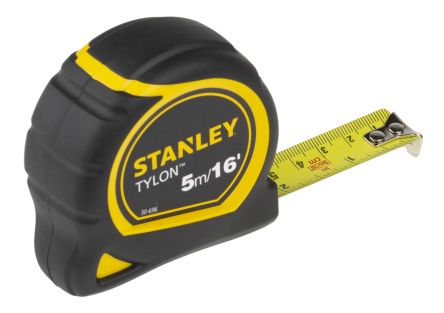
(5m pocket tape measure by Stanley)
- Long measure tapes: designed mostly for engineering and industrial work, they can be as long as 500 feet in length (around 150 metres). They are normally encased in a reel, which can be either closed or open.
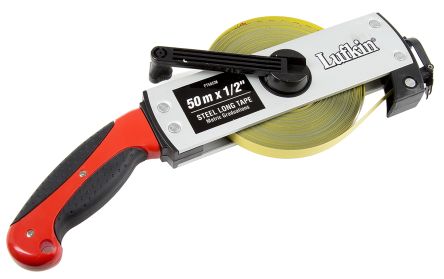
(50m long open case tape measure by Lufkin)
4. Output format
- Analogical tape measures provide the output via the markings on the strip or the blade. Therefore, the precision of the measurement does not only depend on the accuracy of the tape itself but on the user’s attention to detail, too.
- Digital measure tapes were made possible by the mass production of integrated circuits (IC) in the mid-Seventies. They are very similar to a standard encased tape, featuring a metallic hook to be anchored to the starting point of measurement. The only difference is that the readout signal comes from an integrated digital display on the top, which minimises the error that might arise from measuring by eye.
5. Other kinds of tape measures are also available on the market:
- Laser and Infrared measure tapes: despite their name, they do not feature a physical tape or blade, but they share the same measuring function as a traditional one, especially for longer distances. They use laser pointer targets to assess the distance between a point A and point B, combining high precision with an ergonomic design.
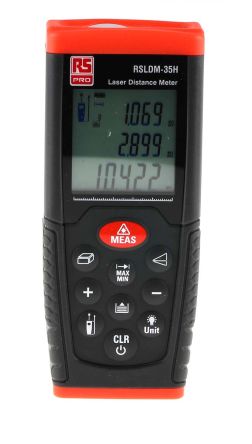
(Laser measure tape by RS Pro)
- Magnetic tape measure: its main feature is the presence of two magnets, one at each end, to ensure they stick to any ferrous material they are held on and make measuring easier.
- Measuring stick: despite not being a tape in the proper sense of the word, measuring sticks are also a popular measuring instrument used by shoemakers, as well as a drawing tool that helps with the creation of straight lines. It is normally wooden or made of plastic, and can be found in different lengths that range from a few centimetres to one metre. When their measuring power is that broad, they can be foldable and extendable, making them easy to store and use.
Popularity and brands
There are various trusted brands that provide measurement tools on the market, whether you need a cheap tape measure for everyday use, or you are on the look for a specialist one suitable for professional purposes.
While Stanley is probably the most popular in carpentry and surveyor industries (meeting customers’ needs with customised tools for easiness of use, like for example left-handed tape measures), there are many other suppliers sharing the scene for these useful and flexible tools: RS Pro, Lufkin tape measure, Facom, CK and Ideal, to name a few.
Tape Accuracy
When it comes to precision work, tape accuracy is a key factor and is determined by standards set by the European Committee, which divide the category in three classes according to their level of accuracy.
- EC Class I: they are the most accurate tape measures on the market. They tend to be slightly more expensive than the average DIY tool, but are perfect for professional work where precision is not something to compromise on. The maximum error expected in class I tapes is of 1.1 mm in 10 meters – 0,001 % of margin.
- EC Class II: slightly less accurate than class one, but still significantly more precise than the average commercial tape and suitable for all uses and pockets. The maximum error expected over 10 meters total length is 2.30 millimetres – slightly more than the 0.002%.
- EC Class III: the least accurate on the scale, therefore they might be preferred where a difference of a few millimetres does not make a difference on the overall result and does not impact the stability or the safety of the project. The maximum margin of error on a 10 metres long measure is 4.60 millimetres – 0.004 % difference.
| Length | Class I | Class II | Class III |
|---|---|---|---|
| 2m | 0.30 | 0.70 | 1.40 |
| 3m | 0.40 | 0.90 | 1.80 |
| 5m | 0.60 | 1.30 | 2.60 |
| 8m | 0.90 | 1.90 | 3.80 |
| 10m | 1.10 | 2.30 | 4.60 |
(Source: https://www.sola.at/global-en/competences/short-tape)
Did you know? – Tape measure trivia
Tape measures might have gone through different tweaks and transformations during the years, and we might now know about them in their different formats, but they have been around for a while. In fact, the first rudimental tape measures date back to the Roman era, when marked strips of leather were used as measuring instruments.
The longest tape measure in the world was a 600 feet (183 metres) gold-plated tape created by Justus Roe, an American surveyor and tape-maker, in 1956.
Product spotlights
Use one of these links to view the products on the RS website
